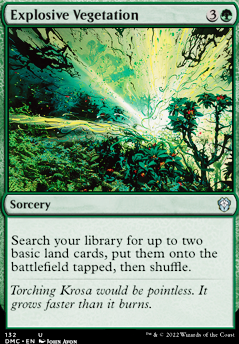Sorcery (16)
- 1x Bitter Ordeal
- 1x Boundless Realms
- 1x Cultivate
- 1x Death Cloud
- 1x Explosive Vegetation
- 1x Grow from the Ashes
- 1x Jokulhaups
- 1x Obliterate
- 1x Rampant Growth
- 1x Ruination
- 1x Scapeshift
- 1x Shattering Spree
- 1x Splendid Reclamation
- 1x Sylvan Awakening
- 1x Tectonic Break
- 1x Tsunami
Artifact (8)
Enchantment (16)
- 1x Blood Moon
- 1x Blood Sun
- 1x Destructive Flow
- 1x Dictate of Karametra
- 1x Elemental Bond
- 1x Heartbeat of Spring
- 1x Khalni Heart Expedition
- 1x Mana Flare
- 1x Nature's Revolt
- 1x Necropotence
- 1x Overabundance
- 1x Primal Order
- 1x Scald
- 1x The Mending of Dominaria
- 1x War's Toll
- 1x Zendikar Resurgent
Creature (6)
Commander (1)
Land (32)
- 13x Forest
- 1x Grixis Panorama
- 8x Mountain
- 1x Myriad Landscape
- 1x Naya Panorama
-
5x
Swamp

- 1x Terminal Moraine
- 1x Terramorphic Expanse
- 1x Warped Landscape
Instant (3)
Maybeboard
Creature (6)
- 1x Avenger of Zendikar
- 1x Flameblast Dragon
- 1x Nesting Dragon
- 1x Omnath, Locus of Rage
- 1x Rampaging Baloths
- 1x Soul of New Phyrexia
Enchantment (1)
Land (6)
Sorcery (4)
Planeswalker (1)
Suggestions
Updates Add
Comments
Attention! Complete Comment Tutorial! This annoying message will go away once you do!
Important! Formatting tips — Comment Tutorial — markdown syntax
Please login to comment
90% Casual
Competitive
| Date added | 5 years |
| Last updated | 5 years |
| Legality | This deck is not Commander / EDH legal. |
| Rarity (main - side) | 6 - 0 Mythic Rares 29 - 0 Rares 11 - 0 Uncommons 10 - 0 Commons |
| Cards | 82 |
| Avg. CMC | 3.48 |
| Tokens | Cat Warrior 2/2 G, Clue |
| Votes | |
| Ignored suggestions | |
| Shared with | |
| Views |


